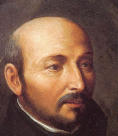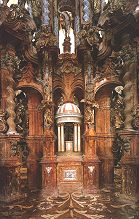|
|
 |
|
The Jesuits: Il Gesu and Sant'Ignazio as Triumphant Churches |
|
written
by hlc / 09.16.2004 |
|
|
|
Historical Information |
| |
Counter Reformation |
| |
In the early 16th century the protestant revolt was exploding throughout Europe. Widespread dissatisfaction with the leadership and policies of the Catholic Church led to the protestant reformation, and eventually the formation and spread of the Protestant faith. The church recognized its need to correct the defects that had provoked the Protestant schism, and so launched an agenda of reform and revival. This movement to counter the spread of Protestantism is called the Counter Reformation.
There were two major components of the Counter Reformation. The Council of Trent, which met intermittently from 1545-1563, worked to re-examine and redefine Catholic doctrine and the role of the clergy. The activity of the Jesuits was another important factor in the Counter Reformation.
|
| |
|
| |
|
| |
Sant' Ignazio |
| |
| |

|
| www.jesuits-europe.org/ mart/ |
| Ignatius of Loyola |
| Saint Ignatius is the founder of the Jesuit Order. |
| |
|
Ignatius of Loyola (1491-1556) was the founder of the Jesuit Society.
He lived in the Basque region of northern Spain, and was a soldier in the Spanish army. He was wounded in war, and while he was recovering he started reading religious books which sparked his interest in the church. When Ignatius was healthy he moved to study the Catholic Church in Paris, and eventually drew a small band of friends whom he directed in prayer and meditation according to his book, “The Spiritual Exercises.” This book discusses the idea of self-mastery, the art of teaching people to deny themselves completely in order to give full obedience to the church. In 1537, Ignatius came to Rome and here he was ordained a priest, and finally, in 1540, Pope Paul III approved the Institute of the Society of Jesus. Ignatius was elected General Superior of the Jesuit Order and served this post until his death in 1556 at the age of 65. The chapel of St. Ignatius in Il Gesu contains his remains.
|
| |
|
| |
|
| |
The Jesuits |
| |
| |

|
| www.marquette.edu/library/ collections/archive... |
| Jesuit Priests |
| A picture of modern day Jesuit preists in their robes. |
| |
|
The basis of the Society of Jesus was to return to the strictest and most uncompromising obedience to the authority of the church and its ecclesiastical hierarchy. The main goals of this order were the propagation of the Catholic Faith, and the promotion of Christian piety. In addition to their three vows (poverty, chastity, obedience) they each took a fourth vow, which obliged them to travel anywhere in the world for ministry according to the Pope’s wishes. This vow extended the Jesuits influence across the world. Their success was enhanced by studying and adapting the language and culture of the countries where they worked.
Education was another important aspect of the Society of Jesus. The Jesuits were called the “schoolmasters of Europe,” due to their schools, their pre-eminence as scholars, and the many textbooks they composed. Jesuit schools promoting intense academic studies became their most characteristic institutions, where scholarship, science, and exploration were the three main tenets. The Jesuits aimed to educate the sons of privileged Catholic families in order to attract the interest of wealthy patrons; they depended on wealthy donors for the financing of their building projects.
However, despite this initial success, a little over two centuries later, in 1773, the Jesuits were disbanded by Pope Clement XIV. This was a political power move on the part of the Catholic Church, who was facing international demands for the total destruction of the Jesuit Society. The property of the Society’s many schools was sold or taken over by the state, their libraries were destroyed, and books burned. However, the order survived and was formally reinstated in 1814 by Pope Pius VII. The society was flooded with requests to take over new colleges; the memory of their educational triumphs had not died.
The Jesuits were a powerful force in the Roman Catholic recovery because they truly embodied the zeal of the movement. The Jesuits became the “Pope’s army” of the Counter Reformation, armed with weapons of advanced academic studies, the education of youth, and zealous missionary activities.
|
| |
|
| |
|
| |
Art After the Counter Reformation |
| |
| |

|
| www.borromini.at/ e/hibarock.html |
| The Baroque Style |
| This is an example of Baroqe work. It is very ornate and is crowded with decoration and color. |
| |
|
| |

|
| www.borromini.at/ e/hibarock.html |
| Baroque Art |
| This statue is an example of the emotion, drama, and realism that was captured in Baroque art. |
| |
|
The tumultuous religious environment of the 16th century caused the church to commission many major art programs. The Catholic Church began to build extravagant churches and monuments in the glory of God, in hopes of making the Catholic faith more appealing. The Church authorities realized that paintings high above the ground offered perfect opportunities to impress their viewers with the Catholic Church’s glory and power, as well as created a spiritual environment; both effects were well suited to the Church’s needs in the Counter Reformation.
Jesuits were aware of the value of sacred images for both praying and for propaganda. They used the persuasive value of religious images, like graphic scenes of martyrdom, to evoke emotions. Imagery of saints was another important aspect of religious art during this time. Saints were images that the laypeople could relate with, and were very specific to the Catholic faith. The promotion of all those aspects of the Catholic Church that were rejected by Protestants became popular images as well, i.e.: angels, the Eucharist, scenes from Mary’s life, etc.
The Catholic Church was influential in the progress of Baroque art and architecture. The church used emotional, realistic, and dramatic art as a means of propagating the faith; opposite from the simplicity Protestants chose to use in their art and architecture. Decadence, preoccupation with the potential of light, contrast of light and dark, sense of movement, energy, emotion, realism, intense spirituality (martyrdoms, ecstasies), and infinite space were all Baroque techniques adopted by the Church. The use of perspective to create an illusion of depth and space was another favorite Baroque technique. Italian Baroque religious art depended on the drama and theatricality of individual images as well as the interaction and fusion of architecture, sculpture and painting; creating visual unity was the goal.
|
| |
|
| |
|
|
 |
|




